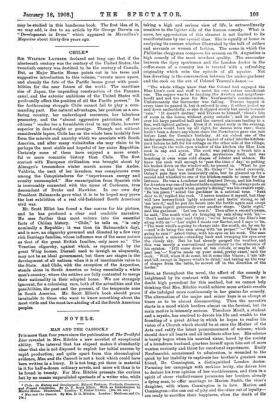THE HERITAGE OF DRESS.*
THIS important-looking book contains a good deal that is very curious and instructive. Mr. Webb approaches his subject from the point of view of the naturalist, observing that "our artificial coverings have become a part of our life," and that he therefore feels justified in treating them "as if they were part and parcel of the creature that wears them." Following the method of Darwin, he -finds in the dress of to-day "vestiges" of various garments no longer worn, their use and object having passed away, and their traces being often retained merely as ornamental. No one who has not studied the subject would believe what historical secrets lie hid in the cut of a coat, in the shape and situation of pockets, above all in buttons. The interest of buttons is universal; it runs all through the book. There was once a definite object in every arrangement of buttons and button- holes. There are deep scientific reasons, dating back centuries, for such facts as that men's upper garments button over from left to right, women's from right to left. There are few buttons which have not an hereditary right to their position ; a button without a pedigree is a despicable button that simply ought not to exist (this doctrine seems con- servative, if not reactionary). A safety-pin comes down straight from the Etruscans with scarcely any development. The livery of servants is a curious study crammed with "vestiges." A groom's leather belt, for instance, belongs to the time when ladies were in the habit of riding on a pillion behind their servants ; it was something to hold on by, no doubt often a necessity from the roughness of the roads. A footman's coat is the coat of a fine gentleman in George III.'s time ; a Sheriff's coachman, with his full-skirted coat and three-cornered bat, dates from further back in the eighteenth century. The great black silk rosette that hangs from the collar of the Lord Mayor's coachman is "a survival of the bag-wig," which has also left traces of itself in the " flash " of Court dress and of the Welsh Fusiliers. Cockades, too, have a long and dis- tinguished descent, and were once, of course, unmistakable marks of position or military rank. Now, Mr. Webb tells us that jobm asters supply the cockade with a brougham or a victoria for sixpence extra! These are only a few of the subjects connected with dress and personal ornament which • The Heritage of Dress: being Notes on the History and Evolution of Clothes. By Wilfred Mark Webb. With illustrations. London : E. Grant Richards. [15s. net.]
may be studied in this handsome book. The first idea of it, we may add, is due to an article by Sir George Darwin on "Development in Dress" which appeared in Macmillan's Magazine about thirty-five years ago.







































 Previous page
Previous page